A gold and garnet cross, found on the chest of a girl buried 1,300 years ago, is set to go on display at the Museum of Archaeology and Anthropology in Cambridge.
The noble girl was buried between around 650AD and 680AD in a very rare Christian 'bed burial', just 15 of which have been found in the UK.
Her grave was discovered seven years ago on a Cambridge housing development being built on land owned by Grosvenor.
Rare gold and garnet Anglo-Saxon cross found 'still gleaming' on the chest of a teenage noble girl buried 1,300 years ago is set to go on display in Cambridge
The cross, found in Cambridge, is thought to be worth £80,000
The cross marked the buried girl out as an early convert to Christianity
The earliest Christians were from noble families, so she may have been of aristocratic or royal blood
By Press Association and Cecile Borkhataria For Mailonline
1 February 2018
A gold and garnet cross, found on the chest of a girl buried 1,300 years ago, is set to go on display at the Museum of Archaeology and Anthropology in Cambridge.
The noble girl was buried between around 650AD and 680AD in a very rare Christian 'bed burial', just 15 of which have been found in the UK.
Her grave was discovered seven years ago on a Cambridge housing development being built on land owned by Grosvenor.
The bed had rotted away leaving only the iron supports and metal brackets. However, the beautiful cross stitched onto her dress was 'still gleaming.'
The cross, thought to be worth more than £80,000, has now been donated by Grosvenor to the museum, where it will go on temporary display with the other grave goods while a permanent case is made.
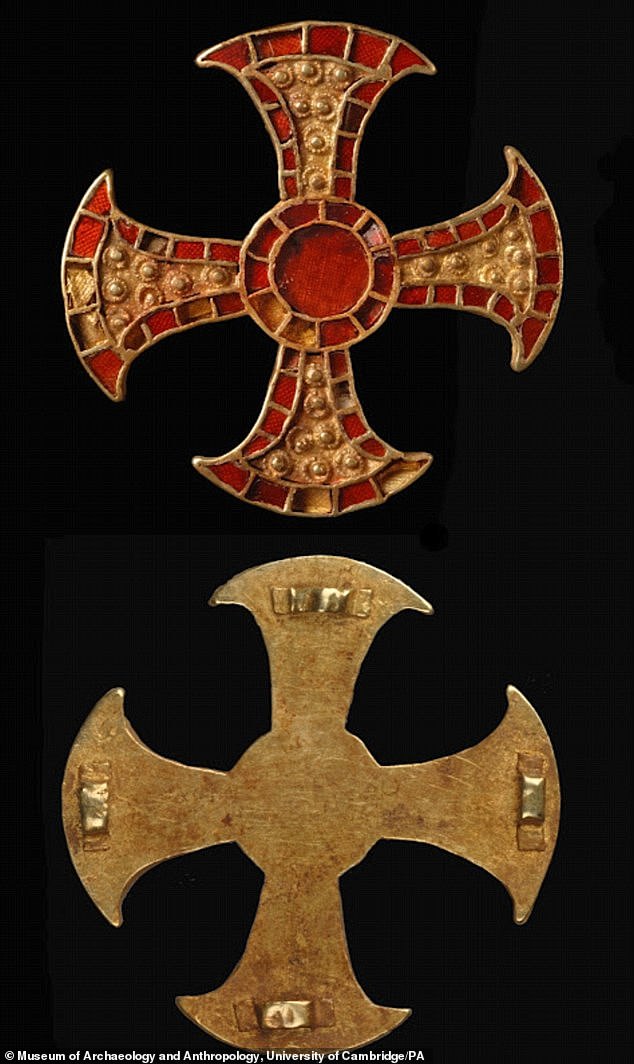
The Trumpington Cross, made of gold and garnet, was found on the skeleton of a girl aged between 14 and 18 years old in one of the earliest Christian burials in Britain, unearthed near Cambridge. The cross is thought to be worth more than £80,000
When she was found, the noble girl was surrounded by treasured possessions including gold pins, glass beads, an iron knife and a chain which would have hung from her belt.
Her bones suggest she was about 14 or 16 year-old when she died, but no clear cause of death was identified.
But it was the cross that excited Cambridge University archaeologists, marking her out as an early convert to Christianity and – as the earliest Christians were from noble families – indicating she was of aristocratic or even royal blood.
In addition, the type of gold and garnet jewellery discovered in her grave was once associated with women belonging to a royal family in Kent, but pieces are now being discovered along England's east coast too.
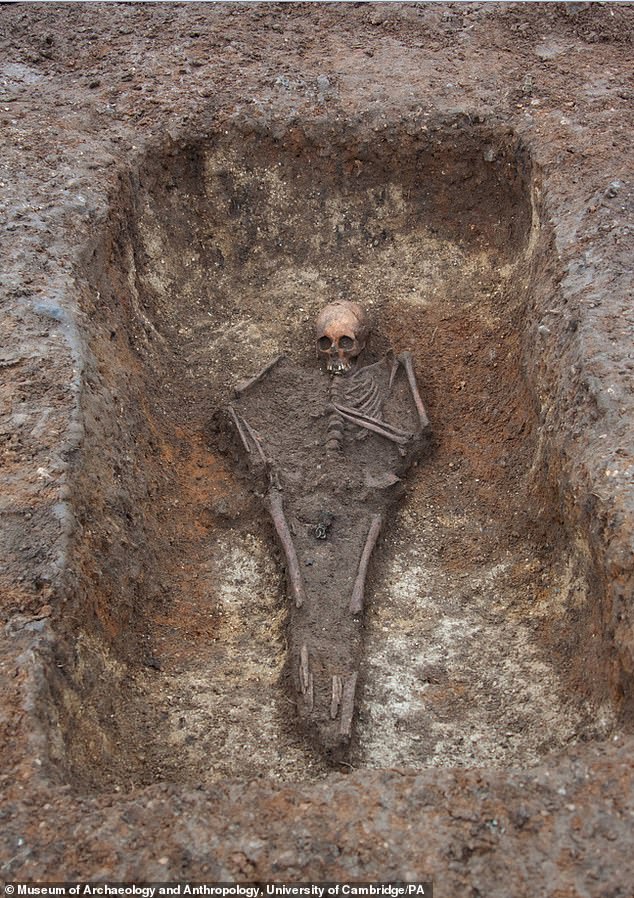
The Trumpington Cross, made of gold and garnet, was found on the skeleton of a girl aged between 14 and 18 in one of the earliest Christian burials in Britain, unearthed near Cambridge. The teenager was buried between around 650AD and 680AD in a very rare 'bed burial'
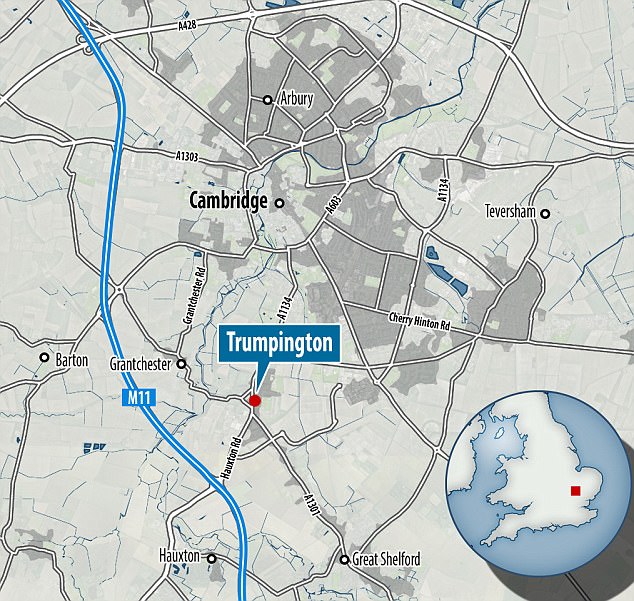
A noble girl buried between 650AD and 680AD in a very rare Christian 'bed burial' was discovered seven years ago on a Cambridge housing development being built on land owned by Grosvenor. The girl's skeleton was discovered in 2011 at Trumpington Meadows
She was discovered in 2011 at Trumpington Meadows, among a group of burials, possibly of relatives, on a site with no previously known Anglo-Saxon connections.
The cross indicated that the girl was an early convert to Christianity, but she was buried in the pagan style with good that were likely prized possessions.
A few other burial sites from the late 7th century have been discovered, all thought to be of women, but only one other had a cross.
Jody Joy, senior curator at the museum, said: 'MAA has one of the best collections of Anglo-Saxon artefacts in the British Isles – and we are indebted to Grosvenor for their generosity in allowing this beautiful, mysterious artefact to remain in Cambridge.
'The Trumpington Cross and other material recovered from the dig are of international quality and significance – but with the strongest connections to Cambridge and the surrounding settlements.
'Taking pride of place in our galleries, the cross will allow us to tell the story of the coming of Christianity to the region and some of the history of this previously unknown Anglo-Saxon settlement – as well as the very early years of the English church after St Augustine was dispatched to England by the Pope in 597AD to convert the pagan Anglo-Saxon kings.'
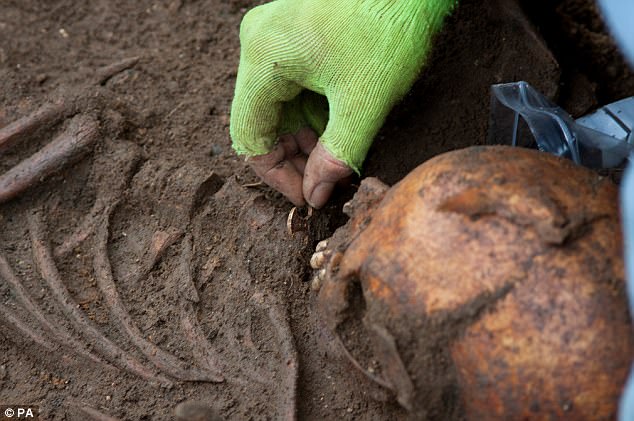
The girl's skeleton was surrounded by treasured possessions including gold pins, glass beads, an iron knife and a chain which would have hung from her belt. But it was the cross that excited Cambridge University archaeologists, marking her out as an early convert to Christianity
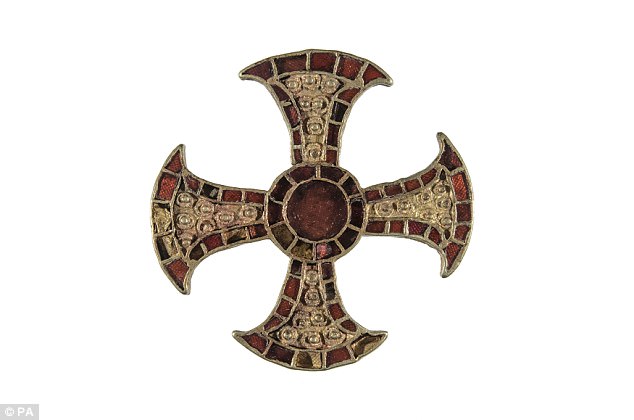
This Trumpington Cross, a 1,300-year-old relic buried with the body of an aristocratic Anglo-Saxon teenager, is going on display just a few miles from where it was found. It was donated by Grosvenor to Cambridge Universityís Museum of Archaeology and Anthropology
WHEN DID CHRISTIANITY COME TO BRITAIN?
In the first century after Christ, Britain had its own gods: Pagan gods of the Earth, and Roman gods of the sky. But soon after, Christianity came to the British Isles.
While people tend to associate the arrival of Christianity in Britain with the mission of St Augustine, who was dispatched to England by the Pope to convert the pagan Anglo-Saxon kings, in 597AD, Christianity arrived long before then in the 1st century AD.
It started when Roman artisans and traders who arrived in Britain began spreading the story of Jesus along with stories of their Pagan gods.
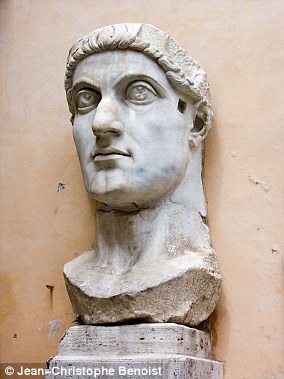
Marble head representing Emperor Constantine the Great, at the Capitoline Museums
At the time, Christianity was one cult among many, but unlike roman cults, Christianity required exclusive fidelity from its followers.
This led to Roman authorities persecuting Christian, who were then forced to meet and worship in secret.
But Roman Emperor Constantine saw appeal in a single religion with a single God, and he saw that Christianity could be used to unite his Empire.
From 313 AD onwards, Christian worship was permitted within the Roman Empire.
During the 4th Century, British Christianity became more visible but it had not yet become widespread. Pagan beliefs were still common and Christianity was a minority faith.
It looked as if Paganism might pervade over Christianity when, after the departure of the Romans, new invaders arrived: Angles, Saxons and Jutes.
Yet Christianity survived on the Western edges of Britain. Missionary activity continued in Wales and Ireland, and in Western Scotland Saint Columba helped to bring a distinctly Irish brand of Christianity to mainland Britain.
It can also be argued that it was St Augustine's famous mission in 597 AD from the Pope in Rome to King Aethelbert of Kent that definitively set up the future of Christianity in Britain, creating an alliance between Christianity and royals.
Read more: Cross found in Christian grave on display in Cambridge | Daily Mail Online
The noble girl was buried between around 650AD and 680AD in a very rare Christian 'bed burial', just 15 of which have been found in the UK.
Her grave was discovered seven years ago on a Cambridge housing development being built on land owned by Grosvenor.
Rare gold and garnet Anglo-Saxon cross found 'still gleaming' on the chest of a teenage noble girl buried 1,300 years ago is set to go on display in Cambridge
The cross, found in Cambridge, is thought to be worth £80,000
The cross marked the buried girl out as an early convert to Christianity
The earliest Christians were from noble families, so she may have been of aristocratic or royal blood
By Press Association and Cecile Borkhataria For Mailonline
1 February 2018
A gold and garnet cross, found on the chest of a girl buried 1,300 years ago, is set to go on display at the Museum of Archaeology and Anthropology in Cambridge.
The noble girl was buried between around 650AD and 680AD in a very rare Christian 'bed burial', just 15 of which have been found in the UK.
Her grave was discovered seven years ago on a Cambridge housing development being built on land owned by Grosvenor.
The bed had rotted away leaving only the iron supports and metal brackets. However, the beautiful cross stitched onto her dress was 'still gleaming.'
The cross, thought to be worth more than £80,000, has now been donated by Grosvenor to the museum, where it will go on temporary display with the other grave goods while a permanent case is made.

The Trumpington Cross, made of gold and garnet, was found on the skeleton of a girl aged between 14 and 18 years old in one of the earliest Christian burials in Britain, unearthed near Cambridge. The cross is thought to be worth more than £80,000
When she was found, the noble girl was surrounded by treasured possessions including gold pins, glass beads, an iron knife and a chain which would have hung from her belt.
Her bones suggest she was about 14 or 16 year-old when she died, but no clear cause of death was identified.
But it was the cross that excited Cambridge University archaeologists, marking her out as an early convert to Christianity and – as the earliest Christians were from noble families – indicating she was of aristocratic or even royal blood.
In addition, the type of gold and garnet jewellery discovered in her grave was once associated with women belonging to a royal family in Kent, but pieces are now being discovered along England's east coast too.

The Trumpington Cross, made of gold and garnet, was found on the skeleton of a girl aged between 14 and 18 in one of the earliest Christian burials in Britain, unearthed near Cambridge. The teenager was buried between around 650AD and 680AD in a very rare 'bed burial'

A noble girl buried between 650AD and 680AD in a very rare Christian 'bed burial' was discovered seven years ago on a Cambridge housing development being built on land owned by Grosvenor. The girl's skeleton was discovered in 2011 at Trumpington Meadows
She was discovered in 2011 at Trumpington Meadows, among a group of burials, possibly of relatives, on a site with no previously known Anglo-Saxon connections.
The cross indicated that the girl was an early convert to Christianity, but she was buried in the pagan style with good that were likely prized possessions.
A few other burial sites from the late 7th century have been discovered, all thought to be of women, but only one other had a cross.
Jody Joy, senior curator at the museum, said: 'MAA has one of the best collections of Anglo-Saxon artefacts in the British Isles – and we are indebted to Grosvenor for their generosity in allowing this beautiful, mysterious artefact to remain in Cambridge.
'The Trumpington Cross and other material recovered from the dig are of international quality and significance – but with the strongest connections to Cambridge and the surrounding settlements.
'Taking pride of place in our galleries, the cross will allow us to tell the story of the coming of Christianity to the region and some of the history of this previously unknown Anglo-Saxon settlement – as well as the very early years of the English church after St Augustine was dispatched to England by the Pope in 597AD to convert the pagan Anglo-Saxon kings.'

The girl's skeleton was surrounded by treasured possessions including gold pins, glass beads, an iron knife and a chain which would have hung from her belt. But it was the cross that excited Cambridge University archaeologists, marking her out as an early convert to Christianity

This Trumpington Cross, a 1,300-year-old relic buried with the body of an aristocratic Anglo-Saxon teenager, is going on display just a few miles from where it was found. It was donated by Grosvenor to Cambridge Universityís Museum of Archaeology and Anthropology
WHEN DID CHRISTIANITY COME TO BRITAIN?
In the first century after Christ, Britain had its own gods: Pagan gods of the Earth, and Roman gods of the sky. But soon after, Christianity came to the British Isles.
While people tend to associate the arrival of Christianity in Britain with the mission of St Augustine, who was dispatched to England by the Pope to convert the pagan Anglo-Saxon kings, in 597AD, Christianity arrived long before then in the 1st century AD.
It started when Roman artisans and traders who arrived in Britain began spreading the story of Jesus along with stories of their Pagan gods.

Marble head representing Emperor Constantine the Great, at the Capitoline Museums
At the time, Christianity was one cult among many, but unlike roman cults, Christianity required exclusive fidelity from its followers.
This led to Roman authorities persecuting Christian, who were then forced to meet and worship in secret.
But Roman Emperor Constantine saw appeal in a single religion with a single God, and he saw that Christianity could be used to unite his Empire.
From 313 AD onwards, Christian worship was permitted within the Roman Empire.
During the 4th Century, British Christianity became more visible but it had not yet become widespread. Pagan beliefs were still common and Christianity was a minority faith.
It looked as if Paganism might pervade over Christianity when, after the departure of the Romans, new invaders arrived: Angles, Saxons and Jutes.
Yet Christianity survived on the Western edges of Britain. Missionary activity continued in Wales and Ireland, and in Western Scotland Saint Columba helped to bring a distinctly Irish brand of Christianity to mainland Britain.
It can also be argued that it was St Augustine's famous mission in 597 AD from the Pope in Rome to King Aethelbert of Kent that definitively set up the future of Christianity in Britain, creating an alliance between Christianity and royals.
Read more: Cross found in Christian grave on display in Cambridge | Daily Mail Online
Follow us: @MailOnline on Twitter | DailyMail on Facebook
Last edited:
